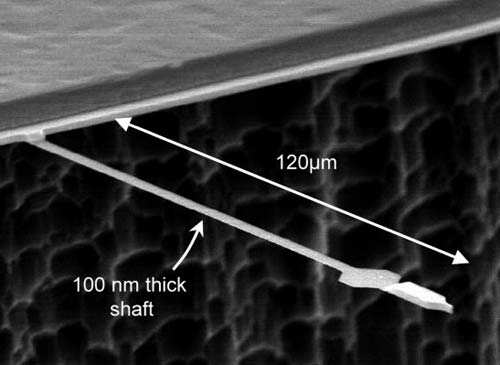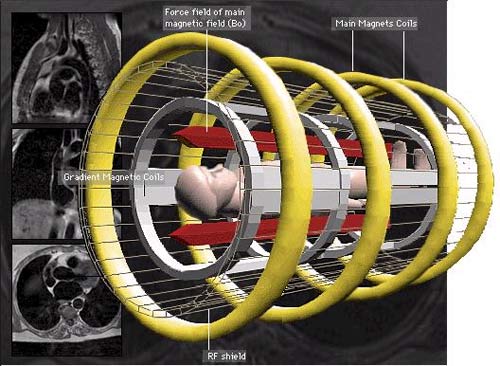Magnetic resonance device reaches 90 nm resolution
US researchers have found a different method than traditional to create magnetic resonance images to observe objects with resolutions up to 90 nm. The best traditional nuclear magnetic resonator has a resolution of about 3 microns. The researchers claim that this new technique (called magnetic resonance force microscopy), can be used to draw nanometer structural maps of structures such as proteins, medicinal drugs. . The results have just been published in Nature Nanotechnology.
Magnetic resonance imaging has been used extensively for a long time in the medical, biological, material science . because it can draw a three-dimensional image of an object. No need to penetrate inside.
This technique is performed by placing the sample in a large one-dimensional magnetic field, and passing it a pulse at the radio frequency band through a metal coil. The radio waves drive the spins of the nucleus away from the direction of the DC magnetic field. At the same time, these nuclei will create a magnetic moment and induce an electric current on the coil and give us information about the local chemical nature in the sample.

Image of a vibrating probe (IBM). - (Photo: Vatlyvietnam)
Traditional magnetic resonators are limited in resolution to a few micrometres, due to their limited ability to create small coils that can create and record radio waves. But recently, John Mamin's team at the Almeden Research Center in IBM (California) found a way to get out of this restriction by removing the coil instead of a probe like the probe in the Magnetic force microscope (see photo). Although magnetic resonance microscopy techniques are no longer new, IBM's team has improved this technique to 90 nm resolution.
This technique involves coating a sample onto the free end of the cantilever of 120 microns long, oscillating with their free frequency. The sample in this case is a sample of CaF 2 (calcium fluoride) made in a cubic shape, placed on the small magnetic tip of the probe, which is a CoFe alloy that creates a focused magnetic field and a locality.

(Photo: Vatlyvietnam)
A nearby coil produces radio waves (to drive the orientation of the spin of the nucleus of the F-19 atom in the sample). Thanks to the vibration movement of the vibrating rod, a part of the object closest to the magnetic probe will go up and down compared to the magnetic field. This creates a force applied to the F-19 atoms near the probe. And this force will change the resonant frequency as well as the vibration amplitude of the vibrating rod, which can be recorded by optical fiber interferometer. The magnitude of this change is proportional to the number of F atoms in the magnetic field, allowing a two-dimensional image of concentration F to be produced by scanning the magnetic probe on the sample.
The researchers claim that they can produce images of about 1,200 atoms in a rectangular block pattern of 80 nm high and 180 nm wide . Different samples vary in length from 165 nm to 295 nm and set 50 nm apart in a straight line. And the device drew images of the characteristics of the samples that removed the 50 nm slots, allowing researchers to confirm the device's resolution to 90 nm (see picture). This is equivalent to recording a volume of up to 650 zeptolite, which is 600,000 times smaller than the ability of the best traditional magnetic resonance device and 70000 times better than magnetic resonance microscopy. the best today.

Resonance imaging from specimens (for 90 nm resolution). - (Photo: Vatlyvietnam)
Although this technique is a very significant improvement in magnetic resonance techniques, it is limited that it is only implemented in vacuum chambers and at temperatures as low as 600 mK to minimize noise for vibrating bars. . And of course, this measurement is not possible under normal conditions, which is still quite far to go into the widespread use of chumg or biological samples in particular.
The Doctrine of Independence
- Magnetic resonance technology replaces cardiac diagnostic techniques
- Wearing a heart aid device can still produce magnetic resonance imaging
- Application of elastic magnetic fluids for nuclear magnetic resonance imaging
- Magnetic resonance imaging tester in milk
- Early magnetic resonance imaging will help save stroke patients
- Guess intent through magnetic resonance imaging technique
- Admire the galaxy's magnetic field with high resolution
- Magnetic resonance imaging finds prostate cancer
- This is a real creature, but can you guess what it is?
- Noise reduction when taking MRI
- Are we only using 10% of the brain?
- Magnetic Resonance Gloves: A development for hand surgery
 Daily use inventions come from universities
Daily use inventions come from universities Special weight loss device helps prevent appetite
Special weight loss device helps prevent appetite 8 inventors were killed by their own inventions
8 inventors were killed by their own inventions Iran invented a motor car powered by water
Iran invented a motor car powered by water